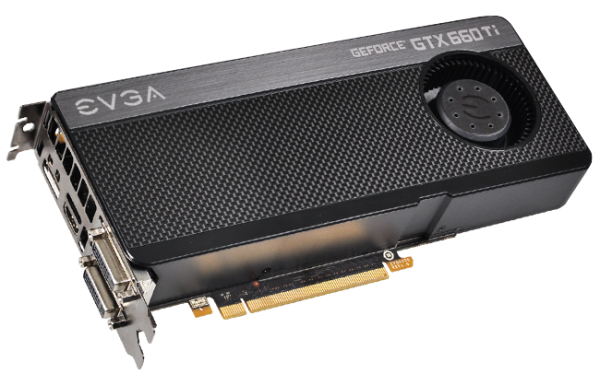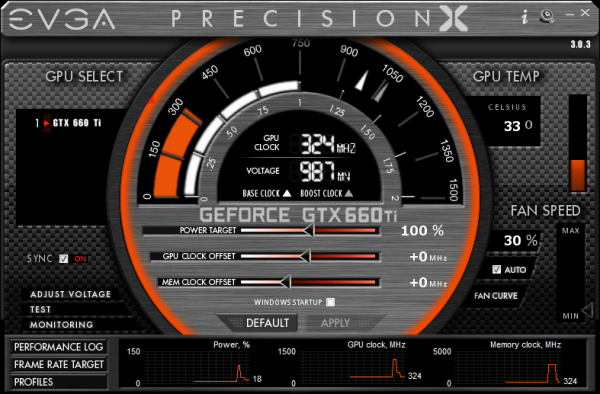The GeForce GTX 660 Ti Review, Feat. EVGA, Zotac, and Gigabyte
by Ryan Smith on August 16, 2012 9:00 AM ESTMeet The EVGA GeForce GTX 660 Ti Superclocked
Our first card of the day is EVGA’s entry, the EVGA GeForce GTX 660 Ti Superclocked. Among all of the GTX 670 cards we’ve looked at and all of the GTX 660 Ti cards we’re going to be looking at, this is the card that is the most like its older sibling. In fact with only a couple cosmetic differences it’s practically identical in construction.
| GeForce GTX 660 Ti Partner Card Specification Comparison | ||||||
| GeForce GTX 660 Ti(Ref) | EVGA GTX 660 Ti Superclocked | Zotac GTX 660 Ti AMP! | Gigabyte GTX 660 Ti OC | |||
| Base Clock | 915MHz | 980MHz | 1033MHz | 1033MHz | ||
| Boost Clock | 980MHz | 1059MHz | 1111MHz | 1111MHz | ||
| Memory Clock | 6008MHz | 6008MHz | 6608MHz | 6008MHz | ||
| Frame Buffer | 2GB | 2GB | 2GB | 2GB | ||
| TDP | 150W | 150W | 150W | ~170W | ||
| Width | Double Slot | Double Slot | Double Slot | Double Slot | ||
| Length | N/A | 9.5" | 7.5" | 10,5" | ||
| Warranty | N/A | 3 Year | 3 Year + Life | 3 Year | ||
| Price Point | $299 | $309 | $329 | $319 | ||
EVGA will be clocking the GTX 660 Ti SC at 980MHz for the base clock and 1059MHz for the boost clock, which represents a 65MHz (7%) and 79MHz (8%) overclock respectively. Meanwhile EVGA has left the memory clocked untouched at 6GHz, the reference memory clockspeed for all of NVIDIA’s GTX 600 parts thus far.
The GTX 660 Ti is otherwise identical to the GTX 670, for all of the benefits that entails. While NVIDIA isn’t shipping a proper reference card for the GTX 660 Ti, they did create a reference design, and this appears to be what it’s based on. Both the EVGA and Zotac cards are using identical PCBs derived from the GTX 670’s PCB, which is not unexpected given the power consumption of the GTX 660 Ti. The only difference we can find on this PCB is that instead of there being solder pads for 16 memory chips there are solder pads for 12, reflecting the fact that the GTX 660 Ti can have at most 12 memory chips attached.
With this PCB design the PCB measures only 6.75” long, with the bulk of the VRM components located at the front of the card rather than the rear. Hynix 2Gb 6GHz memory chips are placed both on the front of the PCB and the back, with 6 on the front and 2 on the rear. The rear chips are directly behind a pair of front chips, reflecting the fact that all 4 of these chips are connected to a single memory controller.
With the effective reuse of the GTX 670 PCB, EVGA is also reusing their GTX 670 cooler. This cooler is a blower, which due to the positioning of the GPU and various electronic components means that the blower fan is off of the PCB entirely by necessity. Instead the blower fan is located behind the card in a piece of enclosed housing. This housing pushes the total length of the card out to 9.5”. Housed inside of the enclosure is a block-style aluminum heatsink with a copper baseplate that is providing cooling for the GPU. Elsewhere, attached to the PCB we’ll see a moderately sized aluminum heatsink clamped down on top of the VRMs towards the front of the card. There is no cooling provided for the GDDR5 RAM.
Elsewhere, at the top of the card we’ll find the 2 PCIe power sockets and 2 SLI connectors. Meanwhile at the front of the card EVGA is using the same I/O port configuration and bracket that we saw with the GTX 670. This means they’re using the NVIDIA standard: 1 DL-DVI-D port, 1 DL-DVI-I port, 1 full size HDMI 1.4 port, and 1 full size DisplayPort 1.2. This also means that the card features EVGA’s high-flow bracket, a bracket with less shielding in order to maximize the amount of air that can be exhausted.
Rounding out the package is EVGA’s typical collection of accessories and knick-knacks. In the box you’ll find a pair of molex power adapters, a quick start guide, and some stickers. The real meat of EVGA’s offering is on their website, where EVGA card owners can download their wonderful video card overclocking utility (Precision X), and their stress test utility (OC Scanner X). The powered-by-RivaTuner Precision X and OC Scanner X still set the gold standard for video card utilities thanks to their functionality and ease of use. Though personally I’m not a fan of the new UI – circular UIs and sliders aren’t particularly easy to read – but it gets the job done.
Next, as with all EVGA cards, the EVGA GeForce GTX 660 Ti Superclocked comes with EVGA’s standard 3 year transferable warranty, with individual 2 or 7 year extensions available for purchase upon registration, which will also unlock access to EVGA’s step-up upgrade program. Finally, the EVGA GeForce GTX 660 Ti Superclocked will be hitting retail with an MSRP of $309, $10 over the MSRP for reference cards.






















313 Comments
View All Comments
CeriseCogburn - Thursday, August 23, 2012 - link
http://www.bit-tech.net/hardware/2012/08/16/nvidia...ROFLMAO - the ONLY REASON you say you wanted the 7950 and it LOSES.
There's the level of "your cred", you freaking loser.
Galidou - Saturday, August 18, 2012 - link
This is only the point of the iceberg when we speak about credibility. Anandtech was nice enough to have a stock clocked part, we can't say that for most of the reviews on the internet.I even got on a website ''not gonna say it, could be too much shame for them'' that was comparing a non reference 660ti overclocked with... suspense... a 7850. And then some times in the review offered an ''alternative analysis'' against a 6870, who's dirty now?
I won't name any but of all the review sites I usually read, they were all testing overclocked cards (plus the included Nvidia boost) against stock clocked AMD cards, ALL of them... Only one included minimum frame rates to all of the games tested which was interesting to see the limiting bandwidth acting at certain points. One can only wonder if the games released won't have any problem with that.
I first came here on anand and almost pulled the trigger buying one RIGHT after finishing reading. Then I visited my other sites and it got all messed up. Anand didn't have minimum frames everywhere, others had different results, the games I play switch from one brand to another for the ''best bang for my bucks''.
With all that mixed up mess, one can only wonder where the ''real'' truth is. I'll probably just end up buying a 7950 overclocking it 40-50% higher and not wonder about future games. At least I waited long enough to see the 660ti. Anyway the other reviewers had quite good result with the 7950 and it was STOCK omg 40-50% overclock can't give a bad performance...
CeriseCogburn - Sunday, August 19, 2012 - link
*OC 660ti's on newegg and only 3 Stock.The author pointed out there is no default version, and Partners have a somewhat free reign on released clocks.
Now be a good person and go look for yourself, you'll have a hard time finding a stock card vs an OC oob card.
I'd also like to see that 40-50% 7950 OC....(methinks you really spewed overboard there)
Reviews are noting a 17%-22% max performance gain on maximum 7950 OC, and that does not mean it's stable, except on a sole rider, non internet server, spanking clean, just defragged, built for benching, top of the line components, reviewer super massive rig.
So, can we get that 50% OC bench set from you ?
NO, of course we can't.
Galidou - Sunday, August 19, 2012 - link
My friend bought the Twin frozr 3 while it was on special on newegg(300$ a week ago). overclocked 1150/1700 stable that's a 44% overclock and he could go higher, with the stock cooler. We reported gains of around 30 to 36% performance gain in games.On newegg, there's plenty of people reporting 1150 to 1200 core overclock, because it is in fact a 7970 board at a very cheap price. If you really can't accept one good thing about AMD that's where I differ from you.
The thing is, Nvidia won this round for the average user, most of us don't overclock and are not fiddling with voltages and such. Including a nice boost is good for those average users, the fact is and whatever you might say, overclockers know it. AMD is very overclocker friendly this gen, end of the line, cry about it some more, it doesn't change the fact that they already know it, sorry. If you tried to misinform the people, you're too late, it's already circulating on the internet my friend.
Now you shall say and I've heard it: ''People have been able to get their gtx680 overclocked to 1300 core in some cases so they are..........''. I know the drill, 680 has for the most part, a boost clock of around 1100 - 1150 boost clock. Lemme translate that, 200mhz overclock on a 1100 boost clock, 18% overclock on the cherry picked 680, because I'm comparing it with a 7950 which didn't pass the 7970 requirement.
CeriseCogburn - Thursday, August 23, 2012 - link
Oh look at that, I didn't use a single fact again.you're pathetic.
CeriseCogburn - Thursday, August 23, 2012 - link
the 660Ti's are hitting 1300+ cores.you're losing at stock out of the box in your highest triple monitor rez dummy
http://www.bit-tech.net/hardware/2012/08/16/nvidia...
Keep attacking like the fool you are.
Now you may apologize profusely and thankme for saving you from your brainwashed amd embolism you claim to have acquired at overclock net
thebluephoenix - Monday, August 20, 2012 - link
Cerise, as a punishment i would make you read few nvidia related articles at site called Semi Accurate to see why is so wrong to be biased idiotic crazy fanboy.CeriseCogburn - Thursday, August 23, 2012 - link
Charlie is a liar, I am not. Deal with it.Galidou - Thursday, August 23, 2012 - link
Everyone is a liar but you Cerise, all hail to you ohh great hardware god, I'm still waiting for news of you on Overclock.net you almighty owner of all the knowledge.Come and teach the nitrogen overclockers of the world about your so great knowledge about video card.
CeriseCogburn - Thursday, August 23, 2012 - link
Yes, time for you to bow down, then thank me for having to correct you three times already, on the FACTS.